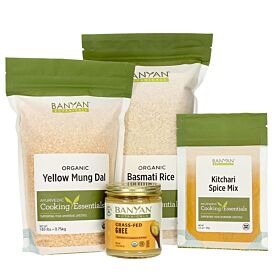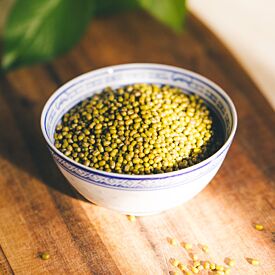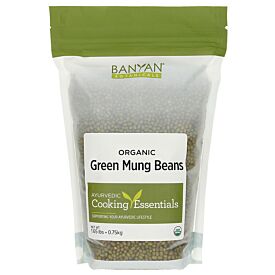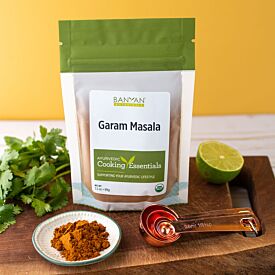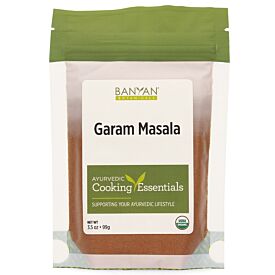The Ayurvedic Diet
When we hear the word “diet,” we often think of a passing fad, a trendy experiment in eliminating general food groups for a short-term goal like weight loss. “Diet” implies restrictions, limitations, and a one-size-fits-all mentality that Ayurveda simply isn’t about.
Ayurveda approaches the concept of dieting in a different way: by teaching us to be more mindful about selecting and preparing foods that will best serve each of us on our unique journeys toward better health and wellness.
In this guide, we’ll cover the basics of the Ayurvedic diet and how to begin cooking Ayurvedically on a regular basis to support your health.
Table of Contents
- What Is an Ayurvedic Diet?
- Learning Your Ayurvedic Diet Type
- Finding What Works for You
- How to Practice Ayurvedic Cooking
What Is an Ayurvedic Diet?
An Ayurvedic diet is not a “diet” in the modern sense of the word, which tends to focus solely on the foods consumed. Instead, Ayurveda offers a much broader approach that encompasses not only what we eat, but also when and how we eat—including our own state of mind—with the ultimate intention to best support a vibrant state of health.
Taking into consideration how we approach our meals, from our own energy and mindset to the times of day we sit down to eat, makes the Ayurvedic diet healthy in a truly holistic way. It takes eating beyond the counting and parsing of calories and individual nutrients, beyond a feeling that eating is almost mechanical, solely to refuel the body. In following an Ayurvedic diet, we are also asked to bring our hearts and our presence each time we sit down to eat.
To understand this holistic approach, we need to delve into some key concepts of Ayurveda, starting with the role of the digestive fire.
Stoking the Fire Within
Most conversations in Ayurveda start with digestion, specifically the digestive fire, or agni, and this is especially true when exploring an Ayurvedic diet. Agni is Sanskrit for “fire” and is viewed as the source of awareness, nutrition, and intelligence—even the very source of life. Agni governs innumerable physiological processes, including the digestion, absorption, and assimilation of food.
With this in mind, it is no wonder that the essence of an Ayurvedic diet revolves around keeping your digestive fire strong!
As the cornerstone to what makes an Ayurvedic diet work, you will find that all of the recommendations within this guide directly support agni—from discovering how your doshas can be your guide, to practicing Ayurvedic food combining, it all comes back to nourishing and protecting your inner fire.
Establishing Consistency in Mealtimes
Perhaps the simplest recommendation, Ayurveda teaches us to eat meals at consistent times each day, with lunch as the largest meal, and to avoid snacking between meals.
Ayurveda is all about creating a healthy daily routine, and the consistency that comes out of this is surprisingly good for agni. Routines can reduce stress and create a sense of regularity, which prepares agni to receive food at consistent times.
When our meals are appropriately spaced, with no snacking in between, we are able to fully digest before introducing more food. This also helps us cultivate natural hunger. As a general guideline, agni needs several hours between meals to fully digest and process, typically 3–6 hours. This is why Ayurveda suggests we avoid snacking—adding more fuel to the fire before it has fully digested the previous meal ultimately weakens agni.
It can be helpful to picture agni as a campfire—when you throw too much wood on the fire it smothers and weakens the flame. Likewise, when you go too long without tending the fire or adding any fuel at all, the flame weakens and peters out. Just like carefully tending a campfire to keep a strong, steady blaze alive, Ayurveda teaches us to tend our agni with just the right amount of fuel—not too little and not too much.
If you want to learn more about agni, we recommend reading our more comprehensive guide, The Importance of Digestion.
Exploring the Doshas and Your Ayurvedic Diet Type
One of the many remarkable truths of Ayurveda is the acknowledgment that we are all unique. This is absolutely true when learning about an Ayurvedic diet and what it means to each of us.
The role and importance of agni is universal to us all—we can all find invaluable support by developing an awareness of our agni, establishing consistent mealtimes, and incorporating basic Ayurvedic cooking principles (which we’ll discuss in a minute).
But when it comes to the actual foods themselves, Ayurveda asks us to fine-tune our meals to honor our individual needs.
This ultimately comes down to the doshas of vata, pitta, and kapha. Just as these doshas combine in varying proportions to account for our unique Ayurvedic body types, the doshas are a part of all manifest phenomena and everything that exists in nature—including the food we eat.
The first step is to discover your Ayurvedic body type, which will give you a clear indication of your Ayurvedic diet type. At a glance, there are three main categories:
- The Ayurvedic diet for vata dosha brings balance to vata by favoring warm, grounding, hydrating foods with a soft and smooth texture. It incorporates a variety of spices and emphasizes proteins and fats.
- The Ayurvedic diet for pitta dosha brings balance to pitta by incorporating foods that are cooling, energizing, somewhat dry, and high in carbohydrates. It encourages eating fresh, whole foods both cooked and raw to decrease internal heat.
- The Ayurvedic diet for kapha dosha brings balance to kapha by including easy-to-digest whole foods that are light, dry, warming, and well-spiced. The best meals for kapha are generally freshly cooked and served warm or hot.
And for all diet types, depending on which dosha you’re balancing, a supportive herbal formula like Vata Digest, Kapha Digest, or Pitta Digest can also help your digestive fire as it acclimates to new types of food and transforms them into nutrients.
Finding What Works for You
As you incorporate certain foods into your diet and reduce others, you might try keeping a food journal and monitoring how you feel after eating. If you begin to wonder whether your Ayurvedic diet is working, remember to be patient with the process. The Ayurvedic diet is a practice of observation and response, a conversation between you and your body as you determine which foods will best nourish and fuel you, and you can fine-tune your approach as you go.
Instead, the value is placed on finding what works for your particular system, and what doesn’t. Often, rather than restricting a food completely, Ayurveda promotes learning how and when to eat that food so that it is as supportive as possible, while causing as little harm as possible.
You may have questions pop up as you go—for instance, is the Ayurvedic diet vegetarian? Are eggs and coffee allowed in an Ayurvedic diet? For the answer to these (and similar) questions—it depends on you and your doshas!
For example, while many Ayurvedic recipes are vegetarian, it is not necessary to be vegetarian in order to follow an Ayurvedic diet, and in some instances, Ayurveda actually recommends eating meat.
Similarly, the question of whether or not to include eggs in your diet depends on your individual constitution. While eggs may be quite beneficial for some people, they can be aggravating for others. The Ayurvedic perspective on coffee and whether you want to incorporate it into your diet also comes down to your doshas.
When considering what to allow and what to restrict, the guidelines for each diet type are an excellent place to begin. But most importantly, pay attention to what works for your unique body and what doesn’t. You may find that some foods just don’t feel right for you and decide to say goodbye for good. Others—like indulgent chocolate treats—shouldn’t be taken on a regular basis but may be enjoyed every once in a while, especially if your digestion is strong.
How to Practice Ayurvedic Cooking
So far, we’ve explored some of the most important factors that go into an Ayurvedic diet. Now let’s highlight some additional concepts to keep in mind while preparing your meals and beverages. These concepts are quite simple, and when followed, they help create the foundation for delicious, wholesome meals that are as tasty as they are healthy and balancing.
Follow Ayurvedic Food Combining Guidelines
Let’s start with choosing what foods to combine into your meal. In Ayurveda, food combining is the idea that certain foods can challenge digestion when paired with food items that are incompatible for one reason or another.
For example, beans and nuts are heavy, rich proteins that are more challenging for the body to break down, so Ayurveda usually does not recommend combining them in the same meal. Melons, on the other hand, are light and digest quickly, which is why Ayurveda recommends eating them alone, or leaving them alone, as eating melons with other foods can result in discomfort, gas, and bloating.
If you’d like to see more examples of compatible and incompatible food items, we encourage you to read An Ayurvedic Guide to Food Combining.
Include the Six Tastes
Ayurveda places a great deal of importance on the rasa, or taste, of foods. Rasa also has other meanings, including “experience,” “enthusiasm,” and “essence.” It plays a crucial role in the process of fully digesting (and experiencing) our food for maximum nutritive benefits.
In Ayurveda, there are six tastes: sweet, sour, salty, bitter, pungent, and astringent. Each of these tastes has a unique action in the body, an affinity for different tissue layers and organs, and can be either balancing or aggravating to the doshas. This means that you can use taste to help ensure your meals are balancing for your Ayurvedic body type.
| Doshas and Tastes | ||
| Dosha | Tastes to Favor | Tastes to Minimize |
| Vata |
|
|
| Pitta |
|
|
| Kapha |
|
|
Knowing how these tastes impact the doshas, you can favor those tastes that are more balancing to your physiology. It’s also important to note that everyone needs all six tastes for optimal balance. When possible, Ayurveda recommends cooking with as many tastes as you can.
Discover the Power of Spices
Ayurveda recognizes that spices have the ability to impart zest, flavor, and sensory pleasure to our meals, while also supporting our overall digestive process. Every spice has a unique set of properties they bring to the body, which affect digestion in different ways. Some help to ignite a low digestive fire, some help to cool an overactive agni, some bring moisture, some dispel gas, and so on.
You can keep your spice rack as simple or elaborate as you wish. Here are just a few of the most well-known Ayurvedic spices to inspire your taste buds and get you started:
- Turmeric is a beloved, bright golden spice found in many traditional Ayurvedic meals. It offers a broad range of beneficial properties, such as bolstering the immune system, strengthening digestion, purifying the blood, and promoting clear, radiant skin.
- Ginger, with its zesty, warming flavor that adds life to both sweet and savory meals alike, is known as “the universal medicine.” It’s an excellent spice for enkindling agni, eliminating toxins, promoting healthy circulation, and supporting the health of the lungs.
- Cinnamon brings a sweet and lively taste that is hard not to love. A warming spice, it supports a strong digestive fire, clears natural toxins from the GI tract, and promotes warmth in the extremities of the body.
- Cardamom is another well-known favorite spice that is excellent for digestive health. This sweet, aromatic spice awakens a healthy appetite, helps to maintain balanced stomach acid levels, and even freshens the breath!
Cooking with spices can be a fun, delicious way to incorporate the six tastes into your meals, while unlocking a whole world of flavor, aroma, and healing benefits. The ways we can turn to spices to support our digestive health are as varied as the spices themselves!
Find Foods Rich in Prana
The term prana has become more recognizable thanks to the rise of yoga’s popularity in the last few decades. Practitioners of yoga will often speak of prana as breath, inspiration, and respiration.
In Sanskrit, prana also means vitality and life force. When you consume foods that are high in prana, you’re consuming that vitality. Pranic foods have a naturally pleasing taste that enlivens the body, mind, and spirit with a sense of deep, fulfilling nourishment.
The closer your food is to harvest, the more prana it will have. For example, a carrot freshly pulled from the earth will be much higher in prana than a can of chopped carrots on a grocery store shelf.
Incorporate Functional Foods and Ayurvedic Superfoods
The terms "functional food" and "superfood" are brand new in comparison to Ayurveda's ancient history. But even if these terms weren't around when Ayurveda developed thousands of years ago, the concept behind them certainly was.
Today, superfoods commonly refer to nutrient-dense foods that are significantly beneficial for health and well-being, while functional foods are recognized as foods that offer beneficial properties beyond their nutritional value alone.
Similarly to foods rich in prana, these types of foods were always encouraged as part of a wholesome Ayurvedic diet. They can naturally and easily be incorporated into your daily meals by favoring fresh fruits and vegetables, nutrient-rich grains and legumes, beneficial cooking spices, and herbal teas and drinks.
Prepare and Eat Meals with Love
Lastly, how you cook and eat is surprisingly important to a healthy Ayurvedic lifestyle.
It is crucial to approach meal preparation with the appropriate mindset. Ayurveda teaches that the mindset and energy of the cook is infused into the meal, so cooking while angry, upset, stressed, or distracted means the food will be imbued with that energy.
Similarly, eating while feeling those emotions will negatively impact your ability to digest your food, leading to the creation of ama.
On the other hand, cooking while fully present, attentive, and emotionally grounded will ensure the quality of the food and the ability to digest it properly, making a much more productive and rewarding experience!
Keeping all of this in mind, we encourage you to approach your meal prep and consumption with a mindset of loving kindness, gratitude, and delight. Rather than trying to do it all perfectly, listen to your body and learn as you go. Allow the process of planning, cooking, and enjoying your meals to be an experience that is deeply satisfying and nourishing to your entire being—body, heart, and soul!




